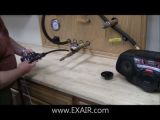I had to find and fix some leaks this week - in my yard. See,
my underground storm sewer pipe, that carries my basement sump pump discharge
and my house's gutter drains to the street, was leaking.
The evidence was clear...swampy puddles were developing in my
neighbor's yard.
The location was clear...several patches of grass in MY yard
were WAY more green and vibrant than the rest.
The cause was NOT clear...until I dug up those patches of the
best looking grass my lawn has ever seen. Turns out, my maple tree's (the
showpiece of my front yard) root system found a way to penetrate one of the
couplings in the sewer pipe, where it prospered into this:

Two days worth of digging up and reinstalling pipe later, and
all is well. I mean, except for filling the trench, sowing some new
grass seed, watching the birds eat it, sowing some more, etc. Ah, the
joys of home ownership...
I tell you all this, dear reader, so you know that I. Don't.
Like. Leaks...whether they be in my storm sewer pipe or in your compressed
air system...which brings me to the (real) subject of my blog today.
Unlike the visual indications of my yard leak, compressed air
system leaks don't really draw much attention to themselves. Unless
they grow quite large, they're typically invisible and very quiet...much too
quiet to be heard in a typical industrial environment, anyway. Good
news is, they're not all that hard to find.
One way is to use a soap-and-water solution. You just
need a spray bottle, some dish soap, and water. Spray it on the piping
joints, and all but the smallest, most minute, of leaks will create soap
bubbles...instant indication of air leakage. This method is inexpensive
and simple, but it does tend to leave little puddles all over. Plus, if
your header runs along the ceiling, you're going to have to get up there to
do it. And unless you can easily maneuver all the way around the pipe,
you can miss a leak on the other side of the joint. If you have a small and
relatively simple compressed air system, and all your piping is accessible
though, this method is tried and true.
For many industrial compressed air systems, though, the
limitations of the soap bubble method make it impractical. But I've got
more good news: those silent (to us) air leaks are making a real racket,
ultrasonically speaking. And we've got something for that:
See, when a pressurized gas finds its way through the narrow
(and usually torturous) path out of a slightly loosened fitting, worn packing
on a valve, etc., it creates sound waves. Some of those ARE in audible
frequencies, but they're often so low as to be drowned out by everything else
that's happening in a typical industrial environment. Those leaks,
however, also create sound waves in ultrasonic frequencies...and EXAIR's Ultrasonic Leak Detector
takes advantage of that ultrasonic racket to show you where those leaks are,
as well as give you a qualitative indication of their magnitude. Here's
how it works:
Find leaks and fix them. This is Step #2 of our Six
Steps To Optimizing Your Compressed Air System. If you'd like to find
out more, give us a call:
Tecmer,Lda
José Garcia Araújo
Tel:+351 932 308 640
Email:j.araujo@tecmer.pt
|


Comentários
Enviar um comentário